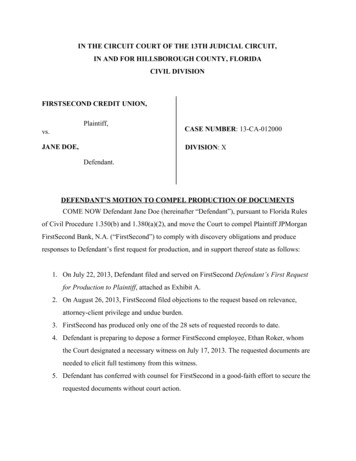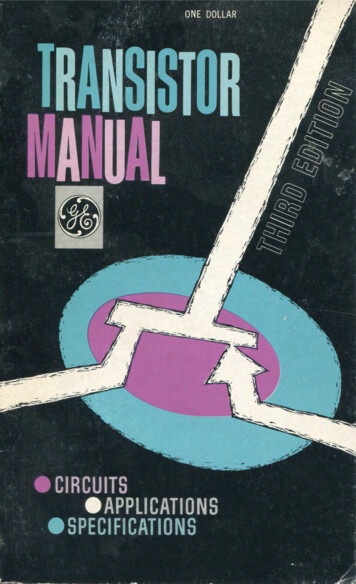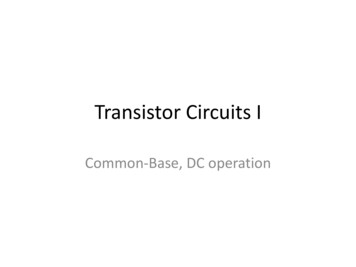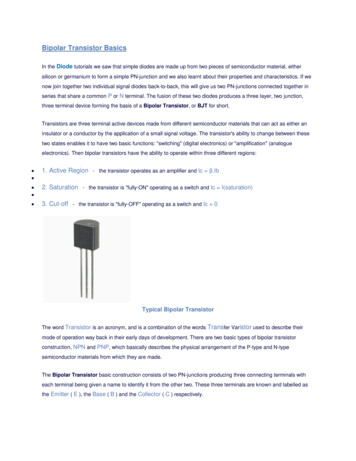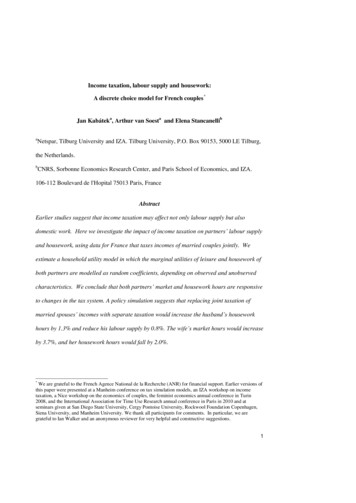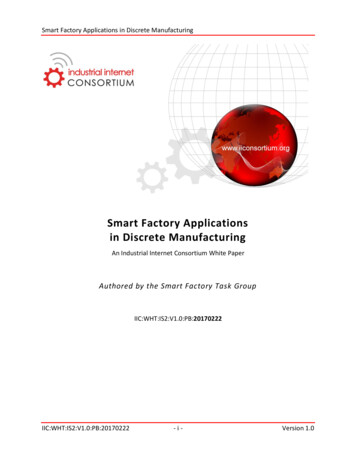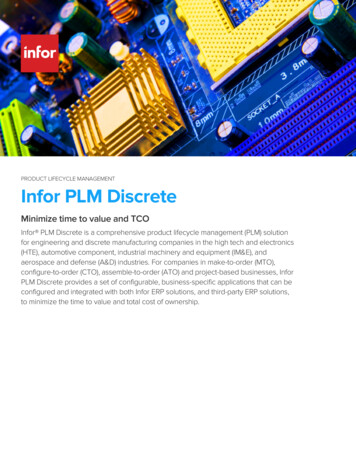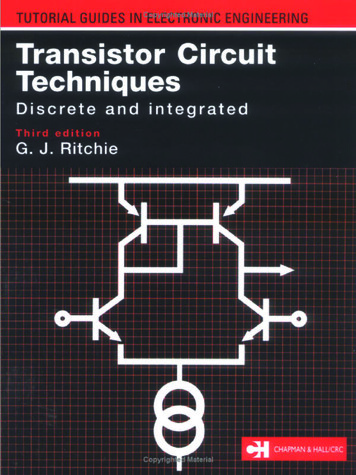
Transcription
Transistor CircuitTechniquesdiscrete and integratedText G.J.Ritchie 1983, 1987, 1993
TUTORIAL GUIDES IN ELECTRONIC ENGINEERINGSeries editorsProfessor G.G.Bloodworth, University of YorkProfessor A.P.Dorey, University of LancasterProfessor J.K.Fidler, University of YorkThis series is aimed at first- and second-year undergraduate courses. Each text iscomplete in itself, although linked with others in the series. Where possible, thetrend towards a ‘systems’ approach is acknowledged, but classical fundamentalareas of study have not been excluded. Worked examples feature prominently andindicate, where appropriate, a number of approaches to the same problem.A format providing marginal notes has been adopted to allow the authors toinclude ideas and material to support the main text. These notes include referencesto standard mainstream texts and commentary on the applicability of solutionmethods, aimed particularly at covering points normally found difficult. Gradedproblems are provided at the end of each chapter, with answers at the end of thebook.Text G.J.Ritchie 1983, 1987, 1993
Transistor CircuitTechniquesdiscrete and integratedThird editionG.J.RitchieDepartment of Electronic Systems EngineeringUniversity of EssexText G.J.Ritchie 1983, 1987, 1993
Text G.J.Ritchie 1983, 1987, 1993The right of G.J.Ritchie to be identified as author of this work has beenasserted by him in accordance with the Copyright, Designs and Patents Act1988.All rights reserved. No part of this publication may be reproduced ortransmitted in any form or by any means, electronic or mechanical, includingphotocopy, recording or any information storage and retrieval system,without permission in writing from the publisher or under licence from theCopyright Licensing Agency Limited, of 90 Tottenham Court Road, LondonW1T 4LP.Any person who commits any unauthorised act in relation to this publicationmay be liable to criminal prosecution and civil claims for damages.First edition published in 1983 by Chapman & HallSecond edition 1987Third edition 199303 04 05 06 / 10 9 8 7 6 5 4 3A catalogue record for this book is available from the British LibraryISBN 0 7487 4075 9Page make-up by Colset Private LtdText G.J.Ritchie 1983, 1987, 1993
ContentsPreface to the third editionPreface to the second editionxixiii1 Introduction to semiconductor devicesObjectivesSemiconductorsThe junction diodeDiode in equilibriumReverse biasForward biasThe diode equationBreakdownDiode capacitanceDiode ratingsDiode modelsd.c. modelSmall-signal a.c. modelBreakdown diodesThe bipolar junction transistorBJT operationBJT current gainBJT characteristicsLoad lineBJT ratingsIntegrated circuitsThe planar processIntegrated BJTsIntegrated diodesIntegrated resistorsIntegrated capacitorsEconomic 920212222232324252 Introduction to amplifiers and biasingObjectivesAmplifier fundamentalsAmplifier gainInput and output resistancesBJT configurationsBJT biasing in common-emitterThe need for biasingConstant base current biasingShunt feedback biasingPotentiometer biasing2626262627282929303234vText G.J.Ritchie 1983, 1987, 1993
Biasing other configurationsCoupling capacitorsDirect couplingSummaryProblems36363839393 Small-signal BJT models and their applicationObjectivesWhy model?A basic BJT modelUse of the modelFull hybrid- modelSimple common-base modelSummaryProblems4343434445485052524 Single-stage BJT amplifiers with feedbackObjectivesSeries feedback amplifierThe emitter followerEffect of emitter decoupling capacitorShunt feedback amplifierHigh-input resistance techniquesCompound-connected BJTsBootstrap bias circuitSummaryProblems55555559626468686972735 Linear integrated circuit techniquesObjectivesThe differential amplifierBalance stateLarge-signal behaviourSmall-signal behaviourCommon-mode performanceEmitter feedbackCurrent sourcesTemperature stabilityOutput resistanceSources or sinks?Current mirrorsBasic current mirrorWilson mirrorActive loadsLevel-shifting circuitsThe amplified diodeA simple operational amplifierThe differential viText G.J.Ritchie 1983, 1987, 1993
SummaryProblems98996 BJT switching circuitsObjectivesBJT regions of operationSimple switching circuitsSingle-stage inverterBJT NOR gateCascaded switching stagesPositive feedback: the bistableTiming circuitsTiming mechanismPulse generatorMonostableAstableCollector waveform improvementIsolating diodeEmitter-followerJunction breakdown protectionJunction breakdownProtection using emitter diodesProtection using base diodesAn integrated circuit timerDifferential comparator 071071091091131151151161161161181181191221251257 Field-effect transistors and circuitsObjectivesThe JFETStructure and operationCharacteristic equationsThe MOSTStructure and operationCharacteristic equationsSmall-signal modelFET amplifiersBiasingCurrent sourcesTemperature stabilityCommon-source amplifierSeries feedback amplifierSource followerDifferential amplifierVoltage-variable resistorFET switchesShunt switchSeries 2143143143145145145viiText G.J.Ritchie 1983, 1987, 1993
MOS logic gatesMOS inverterMOS NOR and NAND gatesCMOS logic gatesSummaryProblems1461461491491501518 Audio power amplifiersObjectivesAn audio systemVoltage, current and powerDistortionPower amplifier output stageClass A and class B operationThe amplified diodeVoltage gain stages and overall configurationCollector load bootstrappingOverall configurationAn audio power amplifier design procedureSpecificationSupply voltage requirementsOutput stage considerationsDriver stageInput sensitivity and voltage gainLow-frequency responseCommentsPerformanceOther aspects of power amplifiersBridge configurationUse of power MOSTsClass D 769 Power supply regulatorsObjectivesIntroductionThe unregulated supplyTransformerRectifierFilterRectifier and capacitor ratingsLinear voltage regulatorsShunt voltage regulatorsSeries voltage regulatorsFeedback series regulators using BJTsOverload protectionSeries regulators using op-ampsRegulator design 198viiiText G.J.Ritchie 1983, 1987, 1993
BJT implementationOp-amp implementationIntroduction to switching regulatorsSummaryProblemsAppendix APreferred values for passive components198200201202203204Appendix B Transient response of R-C circuitsIntuitive solutionDetermination of time constantProblems206208209211Appendix C h-parameter modelling of BJTsCircuit analysis using h-parameters212215References216Answers to problems217ixText G.J.Ritchie 1983, 1987, 1993
Preface to the third editionMany encouraging comments extending back to the launch of the First Editionhave prompted additional chapters on audio power amplifiers and power supplies.Naturally, new concepts are introduced but many of the techniques covered inearlier chapters are reinforced, particularly by the three substantial design studies.Again, as for the Second Edition, the opportunity has been taken to rationalizeand update references to other books, in particular to those in this series.I gratefully acknowledge useful discussion on audio amplifiers with DrMalcolm Hawksford, as well as the careful and constructive comment from myeditor, Professor Greville Bloodworth.G.J.RitchiexiText G.J.Ritchie 1983, 1987, 1993
Preface to the second editionA penalty suffered by the author of the first book in a series is his inability torefer to those that follow. Now with a substantial number of books published inthe series, it is possible in this second edition to cross-reference many of theseexcellent texts. Several new problems have been added and, by popular request,the material on h-parameters has been extended in the form of an additionalAppendix. I am very grateful to Professor John Sparkes (author of the title‘Semiconductor Devices’ in this series) for his detailed comments and revisionssuggested to harmonize our efforts.Preface to the first editionIt has been my experience in teaching electronic circuit design that many firstyear degree students are frustrated by the lack of suitable texts at the right levelof practical and theoretical content. Introductory volumes tend to be ratherelementary while authoritative reference texts prove too extensive for this sensitiveaudience.In this book my aim has been to guide the student gently through the analysisand design of transistor circuits, providing worked examples and design examplesas illustration. Spread liberally throughout each chapter are exercises to test thereader’s grasp of the material and a set of problems at the end of each chapterprovides useful and realistic assessment. Extensive use has been made of margincomments to reinforce the main text by way of highlighting the most importantfeatures, giving references for further reading, recalling earlier material,summarizing the approach and emphasizing practical points.It was considered essential to introduce, at an early stage, the concept ofrepresenting semiconductor devices by simple d.c. and a.c. models which proveso useful in circuit analysis. A brief description of semiconductors and deviceoperation is justified in providing a basis for understanding diode and transistorbehaviour, their characterization and limitations. Great importance is attachedto a basic appreciation of integrated devices, bipolar and field-effect, particularlyin terms of their matching and thermal tracking properties, as well as thefundamental economic law of integration, minimize chip area, which dictatesthe techniques used in modern circuit design.A very simple model of the bipolar transistor is developed using a singleresistor (rbe) and a current source (ßib). This is adequate for most low-frequencyrequirements; only when considering current sources has the rce parameter ofthe full hybrid-p equivalent circuit been invoked. The author does not favour theuse of h-parameters since they are purely numbers and do not give the inherentprediction of parameter variation with bias current and current gain which is theforte of the hybrid-π and simple models.A wide range of transistor circuitry, both linear and switching, is covered interms of fundamental qualitative circuit operation followed by analysis and designprocedure. No apology is made for the extensive analytic treatment of circuitsxiiiText G.J.Ritchie 1983, 1987, 1993
presented in this text—practice in analysis and engendering familiarity with designprocedures are essential facets of the training of an electronic circuit designer.It is hoped that this book instils a sound foundation of concept and approachwhich, even in this most rapidly developing area of modern electronics, willprove to be of lasting value.I am grateful to my colleagues at Essex University, in particular ProfessorsG.B.B. Chaplin and J.A.Turner and Dr J.K.Fidler, for many useful discussions. Ialso wish to thank my Consultant Editor, Dr A.P.Dorey of Southampton University,for his enthusiasm and very constructive assistance with this project.xivText G.J.Ritchie 1983, 1987, 1993
Introduction to semiconductordevicesTo define terms such as intrinsic (pure) and extrinsic (doped) semiconductors,majority and minority carriers.To explain in simple terms how a semiconductor diode operates and how itsd.c. characteristic is expressed analytically by the diode equation.To approximate the d.c. behaviour of a forward biased diode to a constantvoltage and represent its a.c. behaviour by the dynamic slope resistance.To explain junction breakdown and how a breakdown diode can be used as asimple voltage stabilizer.To describe the operation of a bipolar junction transistor (BJT).To define the terms current gain, cut-off and saturation applied to a BJT.To describe the structure of integrated circuit components—BJTs, resistorsand capacitors.To explain the value of the (planar) integrated circuit process in being able toproduce components which are matched and whose parameters track withtemperature.In the design of electronic circuits it is important to know about discretesemiconductor devices such as diodes and transistors, their terminal propertiesand limitations. While device behaviour can be expressed in terms of complexequations, it is much more important to be able to characterize devices in the formof approximate, simple, a.c. and d.c. models which assist in both the analysis anddesign processes.This chapter aims to develop a simple understanding of device operation andcharacterization which subsequently is applied to the design of amplifiers andswitching circuits. Although the emphasis is on discrete components andfundamental circuit techniques, the influence of integrated circuit design is equallyimportant.SemiconductorsA pure or intrinsic semiconductor is conveniently recognized as having aconductivity between that of a metal and of an insulator although, as we shall seelater, this is not the formal definition of the term. Many elements and compoundsexhibit semiconductor properties but in this text we shall restrict our discussion toGroup 4 elements such as silicon.Fig. 1.1a shows a very simple representation of the covalent bonding betweensilicon atoms in a crystal lattice structure. At a temperature of absolute zero thevalence electrons are very tightly bound into the structure; none are free forconduction and the resistivity of the material is very high, approaching that of a1ObjectivesThe following general referencesare useful for this chapter:Millman and Grabel(1987), Chapters 1–5.Sparkes (1987).GaAs, GaP and GaAIAs areparticularly important asmaterials for optical devicessuch as light-emitting diodes,photodetectors and lasers.Germanium has largely beensupplanted by silicon for diodesand transistors and is not usedin integrated circuit f
and design of transistor circuits, providing worked examples and design examples as illustration. Spread liberally throughout each chapter are exercises to test the reader’s grasp of the material and a set of problems at the end of each chapter provides useful
